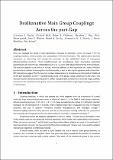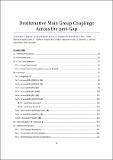Files in this item
Dealkanative main group couplings across the peri-gap
Item metadata
| dc.contributor.author | Taylor, Laurence J. | |
| dc.contributor.author | Buehl, Michael | |
| dc.contributor.author | Chalmers, Brian A. | |
| dc.contributor.author | Ray, Matthew J. | |
| dc.contributor.author | Wawrzyniak, Piotr | |
| dc.contributor.author | Walton, John C. | |
| dc.contributor.author | Cordes, David B. | |
| dc.contributor.author | Slawin, Alexandra M. Z. | |
| dc.contributor.author | Woollins, J. Derek | |
| dc.contributor.author | Kilian, Petr | |
| dc.date.accessioned | 2018-11-30T00:47:02Z | |
| dc.date.available | 2018-11-30T00:47:02Z | |
| dc.date.issued | 2017-12-27 | |
| dc.identifier | 251693563 | |
| dc.identifier | 77ad715b-fd42-4840-9d33-22933baffc0d | |
| dc.identifier | 85038570545 | |
| dc.identifier | 000419082100026 | |
| dc.identifier.citation | Taylor , L J , Buehl , M , Chalmers , B A , Ray , M J , Wawrzyniak , P , Walton , J C , Cordes , D B , Slawin , A M Z , Woollins , J D & Kilian , P 2017 , ' Dealkanative main group couplings across the peri-gap ' , Journal of the American Chemical Society , vol. 139 , no. 51 , pp. 18545-18551 . https://doi.org/10.1021/jacs.7b08682 | en |
| dc.identifier.issn | 0002-7863 | |
| dc.identifier.other | ORCID: /0000-0002-1095-7143/work/48131749 | |
| dc.identifier.other | ORCID: /0000-0002-5366-9168/work/39487833 | |
| dc.identifier.other | ORCID: /0000-0002-2999-2272/work/55901228 | |
| dc.identifier.other | ORCID: /0000-0003-2746-6276/work/56638710 | |
| dc.identifier.other | ORCID: /0000-0002-9527-6418/work/56861557 | |
| dc.identifier.other | ORCID: /0000-0001-6379-3026/work/58285399 | |
| dc.identifier.other | ORCID: /0000-0002-1498-9652/work/59464673 | |
| dc.identifier.uri | https://hdl.handle.net/10023/16583 | |
| dc.description | This work was financially supported by the EPSRC and COST action CM1302 SIPs. | en |
| dc.description.abstract | Here, we highlight the ability of peri-substitution chemistry to promote a series of unique P–P/P–As coupling reactions, which proceed with concomitant C–H bond formation. This dealkanative reactivity represents an interesting and unexpected expansion to the established family of main-group dehydrocoupling reactions. These transformations are exceptionally clean, proceeding essentially quantitatively at relatively low temperatures (70–140 °C), with 100% diastereoselectivity in the products. The reaction appears to be radical in nature, with the addition of small quantities of a radical initiator (azobisisobutyronitrile) increasing the rate dramatically, as well as altering the apparent order of reaction. DFT calculations suggest that the reaction involves dissociation of a phosphorus centred radical (stabilised by the peri-backbone) to the P–P coupled product and a free propyl radical, which carries the chain. This unusual reaction demonstrates the powerful effect that geometric constraints, in this case a rigid scaffold, can have on the reactivity of main group species; an area of research that is gaining increasing prominence in recent years. | |
| dc.format.extent | 1560206 | |
| dc.format.extent | 2514255 | |
| dc.language.iso | eng | |
| dc.relation.ispartof | Journal of the American Chemical Society | en |
| dc.subject | QD Chemistry | en |
| dc.subject | DAS | en |
| dc.subject | BDC | en |
| dc.subject | R2C | en |
| dc.subject.lcc | QD | en |
| dc.title | Dealkanative main group couplings across the peri-gap | en |
| dc.type | Journal article | en |
| dc.contributor.institution | University of St Andrews. School of Chemistry | en |
| dc.contributor.institution | University of St Andrews. EaSTCHEM | en |
| dc.contributor.institution | University of St Andrews. Office of the Principal | en |
| dc.identifier.doi | https://doi.org/10.1021/jacs.7b08682 | |
| dc.description.status | Peer reviewed | en |
| dc.date.embargoedUntil | 2018-11-30 |
This item appears in the following Collection(s)
Items in the St Andrews Research Repository are protected by copyright, with all rights reserved, unless otherwise indicated.


